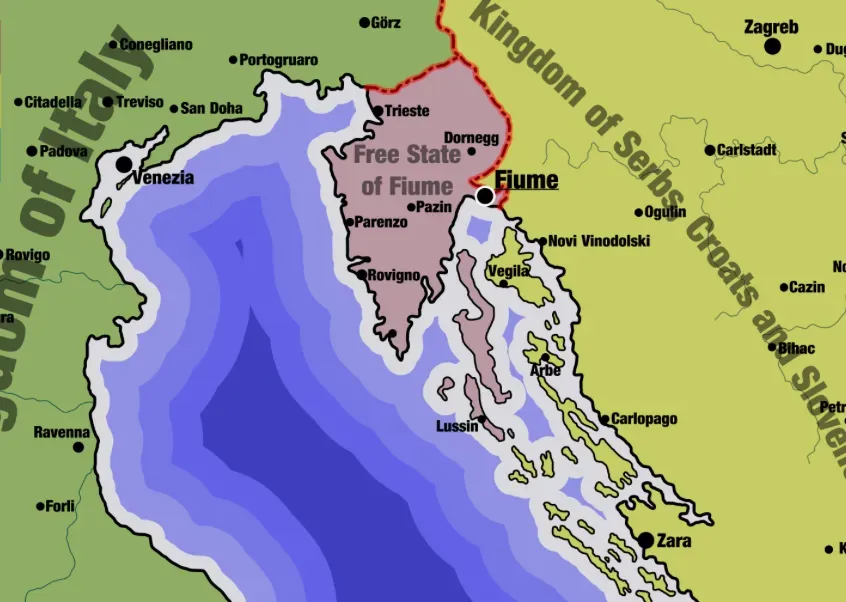The tiny European country that ran on cocaine and yoga

From Terra Nullius: "On the 12th September 1919, Gabriele D’Annunzio proclaimed that he had annexed the city of Fiume to the Kingdom of Italy as the “Regency of Carnaro” - of which he was the Regent. The Italian government was thoroughly unimpressed and refused to recognise their newest purported land, demanding the plotters give up. Instead, D’Annunzio took matters into his own hands and set up a government. The citizens of Fiume quickly found themselves in the midst of one of the 20th Century’s strangest experiments: D’Annunzio instituted a constitution that saw the country divided into nine corporations to represent key planks of industry like seafarers, lawyers, and farmers. There was a 10th corporation that represented those who D’Annunzio called the “Supermen” and was reserved largely for him and his fellow poets."
(Editor's Note: I included the wrong link for a story yesterday about how Jingle Bells was originally a drinking song written by a notorious jerk. If you really wanted to read that one, it is here.)
When a 19-year-old Who fan was pulled from the crowd to fill in for drummer Keith Moon

From The Louder: "In November of 1973, 19-year-old Mike Halpin and a friend travelled from their hometown of Monterey for the Who’s show at the San Francisco Cow Palace. As soon as the concert began, Halpin noticed something was amiss with drummer Keith Moon: A few minutes into Won’t Get Fooled Again he ground to a halt, like a clockwork toy whose battery had just run out. And then he fell backwards, and had to be dragged offstage. When Pete Townshend half-jokingly asked the crowd whether there was a drummer in the house, Halpin's friend pushed him forward. Halpin claimed the last thing he remembered was swallowing a shot of brandy and being introduced to the crowd by Roger Daltrey. However, video evidence shows Scott acquitted himself well. Halpin went on to get married, manage a rock club, play in several groups and become composer-in-residence at the Headlands Centre For The Arts in Sausalito."
France has introduced baguette-scented postage stamps

From Boing Boing: "Every year on May 16, France celebrates Saint Honoré, the patron saint of bakers and pastry chefs. This year, the French postal service La Poste marked the occasion with a delightful tribute—a special postage stamp in his honor. The "Baguette de pain française" stamp not only features a baguette wrapped in a ribbon of France's colors but also features something unusual: it smells like a freshly baked baguette! Yes, it's a scratch-and-sniff baguette-scented baguette stamp. Illustrated by Stéphane Humbert-Basset, this novelty is priced at 1.96 Euros each. La Poste's description of the stamp really gets comically deep into the meaning of the baguette in French culture, describing it as "the bread of our daily life, symbol of our gastronomy, jewel of our culture."
(Editor's note: If you like this newsletter, please share it with someone else. And if you really like it, perhaps you could subscribe, or contribute something via my Patreon. Thanks for being a reader!)
There was a real-life version of Bridgerton's gossip columnist Lady Whistledown

From The Guardian: "She was a real-life Lady Whistledown, an eyebrow-raising female writer who penned a salacious anonymous gossip sheet that skewered 18th-century London society. Like the fictional pamphlet from Netflix hit Bridgerton, Eliza Haywood’s The Parrot, published in 1746, had a distinctive, mocking voice that punched up and “spoke truth to power”. Now a new book will republish Haywood’s funny, subversive periodical, which she wrote from the perspective of an angry green parrot, and seek to raise awareness of her groundbreaking work. A prolific anti-racist, proto-feminist writer, Haywood used her transgressive newsletter to expose 18th-century hypocrisies about race and gender. It was published weekly over nine issues."
The Statue of Liberty was originally designed to represent an Egyptian peasant woman

From Egyptian Streets: "The Statue of Liberty was designed by French artist and sculptor Frédéric Auguste Bartholdi, who, after visiting Egypt in 1855, decided to create a colossal statue intended to rival Egypt’s ancient ones. The statue was meant to stand at the northern entrance to the Suez Canal, a grand project symbolizing the country’s burgeoning industrial development. Bartholdi’s working title was Egypt Bringing Light to Asia, and he designed the figure of a ninety-foot-tall Egyptian peasant woman, her arm upraised, with a torch in hand. Unfortunately, Bartholdi's project was not met with eager anticipation from his Egyptian counterparts. The country was reeling from expenses spilled into the creation of the canal and thus the creation of the colossal statue was deemed too expensive. So Bartholdi’s neoclassical statue would come to be reborn for a different country and under a slightly different guise."
She pioneered counting calories a century ago and we’re still dealing with the consequences
From The Smithsonian: "In 1909 Lulu Hunt Peters had already achieved a rare status for a woman of her time. She earned a doctor of medicine degree from the University of California, when fewer than 5 percent of American medical students were female, and she was the first woman to intern at Los Angeles County General Hospital. Over the next decade, though, what Peters came to regard as her greatest triumph was more personal than professional. As she entered her 40s, Peters used stringent and unrelenting discipline to slim what she described as her “too, too solid” body by dropping 70 pounds. That was what she really wanted to tell people about, with a fervency that approached the messianic. She began tailoring her lectures toward the holy grail she had discovered, a tool that she saw as the key to her weight loss: something called the calorie."
Two skilled performers illustrate how to do the indigenous bamboo dance
This performance is called “Bamboo dance” pic.twitter.com/ynIfuklpXV
— Historic Vids (@historyinmemes) May 17, 2024
Acknowledgements: I find a lot of these links myself, but I also get some from other newsletters that I rely on as "serendipity engines," such as The Morning News from Rosecrans Baldwin and Andrew Womack, Jodi Ettenberg's Curious About Everything, Dan Lewis's Now I Know, Robert Cottrell and Caroline Crampton's The Browser, Clive Thompson's Linkfest, Noah Brier and Colin Nagy's Why Is This Interesting, Maria Popova's The Marginalian, Sheehan Quirke AKA The Cultural Tutor, the Smithsonian magazine, and JSTOR Daily. If you come across something interesting that you think should be included here, please feel free to email me at mathew @ mathewingram dot com



